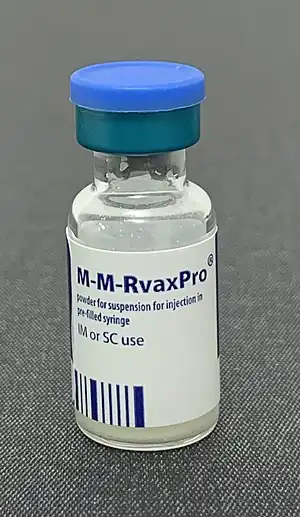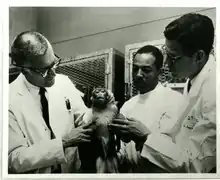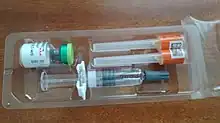Rubella vaccine
 Measles, mumps, and rubella vaccine (live) | |
| Vaccine description | |
|---|---|
| Target disease | Rubella |
| Type | Attenuated virus |
| Names | |
| Trade names | Meruvax, other |
| Clinical data | |
| WHO AWaRe | UnlinkedWikibase error: ⧼unlinkedwikibase-error-statements-entity-not-set⧽ |
| External links | |
| MedlinePlus | a601176 |
Rubella vaccine is a vaccine used to prevent rubella.[1] Effectiveness begins about two weeks after a single dose and around 95% of people become immune.[1] Countries with high rates of immunization no longer see cases of rubella or congenital rubella syndrome.[1] When there is a low level of childhood immunization in a population it is possible for rates of congenital rubella to increase as more women make it to child bearing age without either vaccination or exposure to the disease.[1] Therefore, it is important for more than 80% of people to be vaccinated.[1] By introducing rubella containing vaccines, rubella has been eradicated in 81 nations, as of mid-2020.[2]
The World Health Organization (WHO) recommends that the rubella vaccine be included in routine vaccinations.[1] If not all people are immunized then at least women of childbearing age should be immunized.[1] It should not be given to those who are pregnant or those with very poor immune function.[1] While one dose is often all that is required for lifelong protection, often two doses are given.[1]
Side effects are generally mild.[1] They may include fever, rash, and pain and redness at the site of injection.[1] Joint pain may be reported at between one and three weeks following vaccination in women.[1] Severe allergies are rare.[1] The rubella vaccine is a live attenuated vaccine.[1] It is available either by itself or in combination with other vaccines.[1] Combinations include with measles (MR vaccine), measles and mumps vaccine (MMR vaccine) and measles, mumps and varicella vaccine (MMRV vaccine).[1]
A rubella vaccine was first licensed in 1969.[3] It is on the World Health Organization's List of Essential Medicines.[4] As of 2009, more than 130 countries included it in their routine vaccinations.[1] The wholesale cost of the MMR vaccine in the developing world is US$0.24 per dose as of 2014.[5] In the United States it costs between US$50 and US$100.[6]
Medical uses
Schedule
%252C_OWID.svg.png.webp)
There are two main ways to deliver the rubella vaccine.[1] The first is initially efforts to immunize all people less than forty years old followed by providing a first dose of vaccine between 9 and 12 months of age.[1] Otherwise simply women of childbearing age can be vaccinated.[1]
While only one dose is necessary two doses are often given as it usually comes mixed with the measles vaccine.[1]
Pregnancy
Women who are planning to become pregnant are recommended to have rubella immunity beforehand, as the virus has a potential to cause miscarriage or serious birth defects.[7] Immunity may be verified by pre-pregnancy blood test, and it is recommended that those with negative results should refrain from getting pregnant for at least a month after receiving the vaccine.[7]
The vaccine theoretically should not be given during pregnancy.[1] However, more than a thousand women have been given the vaccine when they did not realize that they were pregnant and no negative outcomes occurred.[1] Testing for pregnancy before giving the vaccine is not needed.[1]
If a low titre is found during pregnancy, the vaccine should be given after delivery. It is also advisable to avoid becoming pregnant for the four weeks following the administration of the vaccine.[8]
Dosage
The defined daily dose is not established.[9]
History

A team of researchers at the National Institutes of Health's Division of Biologics standards developed the rubella vaccine. Lead by Harry M. Meyer and Paul J. Parkman, the team included Hope Hopps, Ruth L. Kirschstein, and Rudyard Wallace among others, the team began serious work on the vaccine with the arrival of a major rubella epidemic in the United States in 1964. Prior to arriving at the National Institutes of Health (NIH), Parkman had been working on isolating the rubella virus for the Army. He joined the laboratory of Harry Meyer.[10]
The first rubella vaccine was prepared by passing the virus through the cells of an African green monkey kidney 77 times.[11]
Parkman, Meyer, and the team from the NIH tested the vaccine at the Children's Colony in Conway, Arkansas in 1965 while a rubella epidemic still raged across the United States.[12] This residential home provided care for children with cognitive disabilities and children who were ill. The ability to isolate children in their cabins and control access to the children made it an ideal location for testing a vaccine without starting an epidemic of rubella. Each of the children's parents provided consent for the participation in the trial.[10]
In June 1969, the NIH issued the first license for commercial production of the rubella vaccine to the pharmaceutical company Merck Sharp & Dohme.[13] This vaccine made use of the HPV77 rubella strain and was produced in duck embryo cells. This version of the rubella vaccine was in use for only a few years before the introduction of the combined measles, mumps, and rubella (MMR) vaccine in 1971.[14]
Types

Rubella is seldom given as an individual vaccine and is often given in combination with measles, mumps, or varicella (chickenpox) vaccines.[15] Below is the list of measles-containing vaccines:
- Rubella vaccine (standalone vaccine)
- Measles and rubella combined vaccine (MR vaccine)
- Mumps, measles and rubella combined vaccine (MMR vaccine)[16][17][18]
- Mumps, measles, rubella and varicella combined vaccine (MMRV vaccine)[19] The measles vaccine is equally effective for preventing measles in all formulations, but side effects vary depending with the combination.[15]
References
- 1 2 3 4 5 6 7 8 9 10 11 12 13 14 15 16 17 18 19 20 21 22 23 24 World Health Organization (July 2011). "Rubella vaccines : WHO position paper". Weekly Epidemiological Record. 86 (29): 301–16. hdl:10665/241786. PMID 21766537.
- Lay summary in: (PDF) https://www.who.int/immunization/position_papers/PP_rubella_July_2011_summary.pdf.
{{cite journal}}: Cite journal requires|journal=(help); Missing or empty|title=(help)
- Lay summary in: (PDF) https://www.who.int/immunization/position_papers/PP_rubella_July_2011_summary.pdf.
- ↑ Suryadevara, Manika (2021). "27. Rubella". In Domachowske, Joseph; Suryadevara, Manika (eds.). Vaccines: A Clinical Overview and Practical Guide. Switzerland: Springer. pp. 323–332. ISBN 978-3-030-58416-0. Archived from the original on 2022-01-06. Retrieved 2022-01-06.
- ↑ Atkinson, William (2011). Epidemiology and Prevention of Vaccine-Preventable Diseases (12 ed.). Public Health Foundation. pp. 301–323. ISBN 9780983263135. Archived from the original on 2017-05-01. Retrieved 1 March 2015.
- ↑ World Health Organization (2019). World Health Organization model list of essential medicines: 21st list 2019. Geneva: World Health Organization. hdl:10665/325771. WHO/MVP/EMP/IAU/2019.06. License: CC BY-NC-SA 3.0 IGO.
- ↑ "Vaccine, Measles-Mumps-rubella". International Drug Price Indicator Guide. Archived from the original on 16 January 2016. Retrieved 8 December 2015.
- ↑ Hamilton, Richart (2015). Tarascon Pocket Pharmacopoeia 2015 Deluxe Lab-Coat Edition. Jones & Bartlett Learning. p. 315. ISBN 9781284057560.
- 1 2 "Pregnancy and Vaccination". Centers for Disease Control and Prevention (CDC). 2019-08-21. Archived from the original on 2019-10-02. Retrieved 2019-10-03.
- ↑ Marin M, Güris D, Chaves SS, Schmid S, Seward JF, Advisory Committee on Immunization Practices, Centers for Disease Control and Prevention (June 2007). "Prevention of varicella: recommendations of the Advisory Committee on Immunization Practices (ACIP)" (PDF). MMWR Recomm Rep. 56 (RR-4): 1–40. PMID 17585291. Archived (PDF) from the original on 2020-02-09.
- ↑ "WHOCC - ATC/DDD Index". www.whocc.no. Archived from the original on 24 September 2020. Retrieved 22 September 2020.
- 1 2 Parkman, Paul. "Dr. Paul Parkman Oral History" (PDF). Office of NIH History. National Institutes of Health. Archived from the original (PDF) on December 13, 2019. Retrieved October 13, 2018.
- ↑ Parkman, P.D.; Meyer, H.M.; Kirschstein, R.L.; Hopps, H.E. (November 1966). "Development and characterization of a live attenuated rubella virus". The Journal of Pediatrics. 69 (5): 893. doi:10.1016/S0022-3476(66)80490-0. Archived from the original on August 29, 2021. Retrieved October 13, 2018.
- ↑ Milford, Lea. "Arkansas Children's Colony aka: Conway Human Development Center". Encyclopedia of Arkansas History and Culture. Archived from the original on October 14, 2018. Retrieved October 13, 2018.
- ↑ Wendt, Diane. "Combating infectious disease and slaying the rubella dragon, 1969-1972". O Say Can You See?. National Museum of American History. Archived from the original on October 14, 2018. Retrieved October 13, 2018.
- ↑ "Rubella". historyofvaccine.org. 7 February 2019. Archived from the original on 1 May 2021. Retrieved 29 January 2020.
- 1 2 World Health Organization (April 2017). "Measles vaccines: WHO position paper – April 2017". Weekly Epidemiological Record. 92 (17): 205–27. hdl:10665/255377. PMID 28459148.
- Lay summary in: (PDF) https://www.who.int/immunization/policy/position_papers/WHO_PP_measles_vaccine_summary_2017.pdf?ua=1.
{{cite journal}}: Cite journal requires|journal=(help); Missing or empty|title=(help)
- Lay summary in: (PDF) https://www.who.int/immunization/policy/position_papers/WHO_PP_measles_vaccine_summary_2017.pdf?ua=1.
- ↑ "M-M-R II- measles, mumps, and rubella virus vaccine live injection, powder, lyophilized, for suspension". DailyMed. 24 September 2019. Archived from the original on 6 April 2020. Retrieved 29 January 2020.
- ↑ "M-M-RVaxPro EPAR". European Medicines Agency (EMA). 17 September 2018. Archived from the original on 6 April 2020. Retrieved 29 January 2020.
- ↑ "Priorix - Summary of Product Characteristics (SmPC)". (emc). 14 January 2020. Archived from the original on 6 April 2020. Retrieved 29 January 2020.
- ↑ "ProQuad- measles, mumps, rubella and varicella virus vaccine live injection, powder, lyophilized, for suspension". DailyMed. 26 September 2019. Archived from the original on 6 April 2020. Retrieved 29 January 2020.
External links
| Identifiers: |
|---|
- Rubella virus vaccine Archived 2014-11-19 at the Wayback Machine on MedicineNet
- Rubella Archived 2014-11-29 at the Wayback Machine on vaccines.gov
- Rubella Vaccine at the US National Library of Medicine Medical Subject Headings (MeSH)